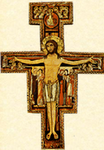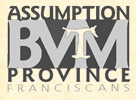
With the passing of Patriarch Alexiy II of Moscow and All Russia I thought it opportune to mention the relationship between Orthodox Russia and the Franciscan Friars.
The relationship between the Orthodox East and the Catholic (and Protestant) West has been contentious for many centuries. After the fall of Constantinople to the Ottoman Turks in 1453, Moscow's metroplitanate declared itself the "Third Rome", to the consternation of the first Rome -- in Italy -- which was in the throes of its own crisis, the Great Schism among competing men bearing the title "pope" of Rome.
Russian Orthodox clergy bid farewell in Moscow to the late Patriarch Alexiy II
Also, due to various Western incursions, such as the Teutonic Knights in the Middle Ages, Napoleon's invasion of Russia in the early 1800s and, most recently, Nazi Germany's invasion of Russia and Soviet-controlled lands (e.g. Ukraine, Lithuania) at the time during World War II-- have made Russia historically sensitive to and suspicious of Western advances (i.e. Western Europe and North America).
So, when the Soviet Union collapsed in the early 1990s and the glasnost and perestroika policies of Mikhail Gorbachev and his successor, Boris Yeltsin, opened the former USSR to expressions of democracy -- including freedom of religion -- the Franciscan Friars (OFM) saw this as an opprtunity of God's grace and providence and so decided to reach out to Roman Catholics in the former Soviet Union who were not previously able to freely express themselves or practice their faith.
This included persons who were ethnically Poles, Germans, Slovaks, and Lithuanians who were, at least, nominally Catholic before their parents' and grandparents' forced migration to the regions of Siberia.
This, however, was met with suspicion by the resurgent Russian Orthodox Church which accused the Roman Catholics of proselytism (i.e. the practice of seeking converts). Our General Minister at the time, Fr. Herman Schaluk, OFM and members of his General Council visited the late patriarch in Moscow to assure him that the only intention of the friars minor was to minister to those who were already Roman Catholics and not to actively seek new converts to the Catholic Church.

Bro. Mario Nagy, OFM (right) of our province receiving the renewal of temporary vows of a young friar in Ussurysk, Siberia, Russia in 2006
The Franciscan friars went to the former Soviet Union and, in various countries, have done a significant outreach and ministry among those Roman Catholic descendants of Europeans displaced during the regime of Joseph Stalin.
Bp. Henry Howaniec, OFM (born of Polish parents in Chicago, IL), a member of our province who served at our General Curia in Rome for many years volunteered to serve in Kazakhstan and was named by the late Pope John Paul II to be bishop of the Catholic diocese in Almaty. (Having reached his 75th birthday, Bp. Henry submitted the mandatory request to the Holy See for retirement.)
Bro. Mario Nagy, OFM (pictured above), also from our province -- who had served for many years in our former missions in the Philippines -- likewise volunteered and lived and served in far eastern Siberia (not too far from the border with North Korea)! Due to increased restrictions on foreigners by the Russian government, Bro. Mario has come back Stateside to help here in the US.
Fr. Blase Karas, OFM, born in Poland before World War II and, as a child, was a refugee under Stalin's USSR in Siberia (Poland was divided between Nazi Germany and the Soviet Union during World War II). He returned to Russia, this time to serve in central Russia in the western Siberian city of Novosibirsk. He has returned to the States and is working among Eastern European immigrant men recovering from alcohol addiction in Chicago, IL.
As instruments of peace, the Franciscan friars -- following the example of our holy founder, St. Francis of Assisi -- seek to respect the integrity of the Orthodox Church of Russia and to serve among those people who are Roman Catholic as well as those -- even indigenous Russians -- who choose on their own (not through proselytism!) to be received into the Catholic Church.

Russian Orthodox faithful in Moscow mourn the passing of Patriarch Alexiy II of Moscow and All Russia
And so, we mourn with our Russian Orthodox brothers and sisters, both in Russia and abroad, the death of their Patriarch Alexiy II of Moscow and All Russia. May God grant his servant blessed repose and eternal memory. And may there be increased trust and charity between the Orthodox Churches and the Catholic Church, in the name of our one Lord Jesus Christ. Amen.
 With the passing of Patriarch Alexiy II of Moscow and All Russia I thought it opportune to mention the relationship between Orthodox Russia and the Franciscan Friars.
With the passing of Patriarch Alexiy II of Moscow and All Russia I thought it opportune to mention the relationship between Orthodox Russia and the Franciscan Friars.



















